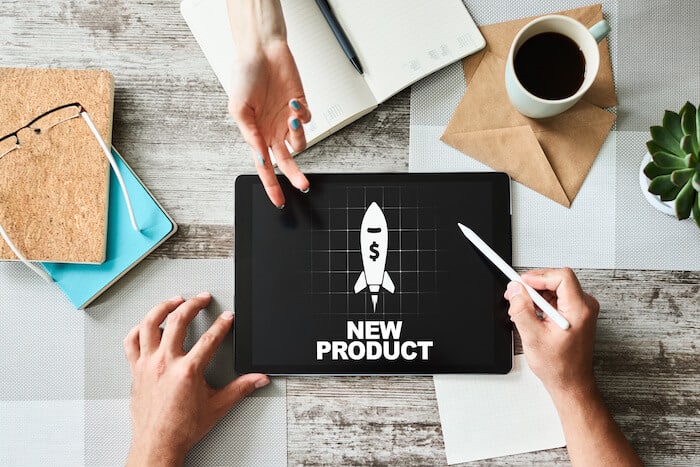It’s an age-old question — How can your product company increase sales in an ever-changing and competitive market? For a while, you could just ride the wave created by new e-commerce platforms or the growing adoption of Amazon. Great marketing strategies and white-labeling popular products were proven ways to grow revenue and make your company more attractive to potential acquirers. Until everyone else started doing the same thing.
One way to break away from the pack and to create significant value is to do something new. And that is why new product development (NPD) is something your company should consider as a way to differentiate itself and reap some significant advantages. Developing a new product concept that focuses on customer needs also takes advantage of all the pieces you already have in place. If you direct your development team to understand and optimize your new product ideas to maximize customer value, your final product will open up new markets and grow market share in your existing target market.
The key word in new product development is “new.” Marketing something already on the market is not enough to stand out in the crowded world of Amazon listings, Shopify stores, or on retail shelves, it now requires more. In this article, we will explain some of the advantages of bringing a unique solution to the market, share the five steps we have learned that lead to successful new product development, and finish with some practical advice on execution.
The Advantages of New Product Development
Although there is additional time and cost associated with innovating a new product for the market, the benefits can be significant. To understand and maximize those advantages, you have to be clear about your company’s goals. Are you trying to boost profit, grow revenue, or increase your company’s value for acquisition? In most cases, your goals will be some combination of all three, and new product development can improve each of them.
When done right, commercialization of a successful product with significant product innovation delivers on the following:
- Creates a deep moat around your product that defends it against the competition
- Extends your potential revenue with existing customers, providing greater customer lifetime value
- Lowers overhead by consolidating operations and using your existing operations and supply chain network.
- Increases your total addressable market by designing a product that appeals to more customers.
- Leverages your current marketing with minimal incremental cost
- Stands out in a crowded market, and especially on social media, with something unique
- Competes on value proposition and innovation instead of price
- Maximizes your profit over time
Bringing an entirely new product to market or adding new features to upgrade an existing product moves your company from the world of “us too” to leadership in your industry. In the crowded world of e-commerce sales, you can try to stand out with better product listings, compelling social media campaigns, and competing on price. Or you can create your own space, your own market, with something new, different, and appealing to customers.
Successful New Product Development in Five Steps

1. Focus on Customers and What They Need
Discipline yourself and your team to keep your focus on the customer, and, most importantly, find out who those potential customers are. Use business analysis to determine your target market and create accurate customer personas describing what is important to each type of potential buyer. If possible, try to talk to representative people from each target group and get first-hand knowledge on what they care about and what motivates them. At the end of this step, you should have a very clear idea of who your customers are.
2. Research Your Customers, the Market, and Your Competitors
Once you have identified who you are selling to and, from a high-level perspective, what they are looking for, invest time in solid market research. Any decisions you make further in the process not backed by research are just guesses. There are two types of research you need to do: qualitative and quantitative.
Qualitative research looks at the aspects of your market and your customer that can’t be measured with numbers. A great place to start is to delve into how your customers are being served by the current product you or your competitors are offering. Move from there to identifying opportunities to provide greater value or to fill unmet needs.
And then, talk to your target customers. You can do this individually through short surveys, customer reviews, or monitoring social media. Or, you can work with experts who conduct interviews and surveys. This qualitative information will help you determine the direction and fundamental differentiation for your new product, specifications that you will solidify with quantitative research and then use to drive your design.
The quantitative side of product research is all about the numbers and the details of what the market wants and what your product needs to be. Take advantage of available tools to scan e-commerce websites and commercial databases to find out what is selling, and more importantly, what is not. Start with an Amazon Search Terms Report (SFR) to see what people are looking for This is also where you find variations in existing products.
Likewise, it is where you need to start looking at the dollars. Gather data on costs and pricing that is already in your segment. Use real-world information to get a handle on what people are paying and how much they will pay for additional features.
At the end of this step, you should have a well-documented picture of the market opportunity and what your product needs to do, along with ballpark figures for cost and price.
3. Create a Design

One way to keep costs under control is to focus on incremental innovations to your existing products. Explore aesthetic changes like offering more color options, changing packaging, or updating your user interface. If your product involves some sort of case or enclosure, spending time with an industrial designer to do some brainstorming, ideation, and sketching is a fantastic way to improve a product’s look and feel and make something new for the market.
If your research uncovered enough potential to justify the cost, then your design process should focus on innovation. Use brainstorming and other forms of idea generation to assess the feasibility of new functionality added to an existing product line or a new product. Seek to discover unique, significant features that expand your target audience. Beyond new features, a viable product may also include new material options, or you may find new ways to combine existing features from two separate products in a new hybrid.
At the end of this step, you should have the deliverables you need for manufacturing, your tech pack, CAD models, and a bill of materials.
4. Source Your Partners
Once you finish the initial steps in your design, it’s time to start sourcing your partners. Good new product development includes design for manufacturing, and the best way to implement that is to identify your manufacturing partners and involve them in the process.
Sourcing partners for new product development is significantly different from deciding to offer an existing product. You can’t just log in to Alibaba, pick three factories, and get quotes. Manufacturing a new product is a collaborative experience. And most importantly, you need to trust the factory or the agent you choose to work with.
Here are some suggestions developed by Gembah after helping dozens of our clients find the right sourcing partners for their product launch:
- Visit the factory, or have your trusted representative visit on your behalf.
- Start your search with a functional product design backed by your product specification.
- Know the key people in the organizations you may work with.
- Let cultural norms shape your negotiations.
- Think long-term, but keep your options open.
- Pay your partners on time.
- Take the time to conduct due diligence.
At the end of this step, you should have your manufacturing partners chosen, contracts in place, and their signoff that they can make your complete new product design.
5. Manufacture Your New Design
The final step in new product development is to get your product made. There is a strong temptation at this point to sit back, take a break from product management, and wait for containers of your shiny new product to show up in a port. This is a huge mistake.
Now is the time for you to be super diligent and work hand in hand with your suppliers to not just make sure your product is made right but to partner on keeping costs down. Good product development is also about continuous improvement, so work with your design and manufacturing team to capture metrics and implement product and process improvements.
A good product development strategy in the early stages of manufacturing is to plan on an iteration or two of your product so you may validate the appeal of your product to your end-users. Your design team should work with your manufacturing partners to turn early feedback into design changes that enhance the value of your product to your target market.
At the end of this step, you should have your product delivered to wherever you will keep your inventory, and you can begin to focus on marketing and sales.
Execution Advice for New Product Development

There are many different proven new product development processes. One that works very well for “customer first” new product development efforts is lean product development. The approach focuses on reducing waste and increasing the efficient transfer of knowledge without stifling innovation. Lean product development delivers better product performance, faster time to market, and increased profit. And most importantly, delivering customer value is built into every aspect of this well-proven approach.
Another suggestion is to use industrial design as the early stages of your NPD Process. Like lean product development, good industrial design is laser-focused on incorporating customer input into your design while also appealing to the emotional impact a product can have. Good design thinking, ideation, sketching, and prototyping can all drive towards greater sales and profits.
And finally, as is usual in all aspects of business, you need to focus on building the right team. This goes beyond your own internal team — it also includes consultants and companies you partner with. Bringing in experts is ideal because many aspects of new product development require special knowledge and skill, and only for a short period. This is why Gembah has built the world’s first global marketplace of industry-leading experts who can be plugged into your process and supplement or guide your existing team where and when needed.
New Product Development Is a Team Sport
When you decide that it’s time to break away from the pack, create greater opportunities, increase your profit, grow your revenue, and ultimately improve your company’s value to potential acquirers, Gembah is ready to be your innovation partner. Reach out to us, and let’s start the journey together.



